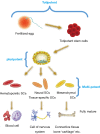Stem cell-based regenerative medicine
- PMID: 31463312
- PMCID: PMC6691074
- DOI: 10.21037/sci.2019.06.04
Stem cell-based regenerative medicine
Abstract
Recent developments in the stem cell biology provided new hopes in treatment of diseases and disorders that yet cannot be treated. Stem cells have the potential to differentiate into various cell types in the body during age. These provide new cells for the body as it grows, and replace specialized cells that are damaged. Since mesenchymal stem cells (MSCs) can be easily harvested from the adipose tissue and can also be cultured and expanded in vitro they have become a good target for tissue regeneration. These cells have been widespread used for cell transplantation in animals and also for clinical trials in humans. The purpose of this review is to provide a summary of our current knowledge regarding the important and types of isolated stem cells from different sources of animal models such as horse, pig, goat, dog, rabbit, cat, rat, mice etc. In this regard, due to the widespread use and lot of attention of MSCs, in this review, we will elaborate on use of MSCs in veterinary medicine as well as in regenerative medicine. Based on the studies in this field, MSCs found wide application in treatment of diseases, such as heart failure, wound healing, tooth regeneration etc.
Keywords: Mesenchymal stem cells (MSCs); animal model; cell-based therapy; regenerative medicine.
Conflict of interest statement
Conflicts of Interest: The authors have no conflicts of interest to declare.
Figures







Similar articles
-
Basic science and clinical application of stem cells in veterinary medicine.Adv Biochem Eng Biotechnol. 2010;123:219-63. doi: 10.1007/10_2010_66. Adv Biochem Eng Biotechnol. 2010. PMID: 20309674 Review.
-
Adult mesenchymal stem cells and their exosomes: Sources, characteristics, and application in regenerative medicine.Life Sci. 2020 Sep 1;256:118002. doi: 10.1016/j.lfs.2020.118002. Epub 2020 Jun 29. Life Sci. 2020. PMID: 32585248 Review.
-
Adipose-derived stem cells and periodontal tissue engineering.Int J Oral Maxillofac Implants. 2013 Nov-Dec;28(6):e487-93. doi: 10.11607/jomi.te29. Int J Oral Maxillofac Implants. 2013. PMID: 24278946 Review.
-
Recent Advances in Endocrine, Metabolic and Immune Disorders: Mesenchymal Stem Cells (MSCs) and Engineered Scaffolds.Endocr Metab Immune Disord Drug Targets. 2018;18(5):466-469. doi: 10.2174/1871530318666180423102905. Endocr Metab Immune Disord Drug Targets. 2018. PMID: 29692270 Review.
-
Isolation and characterization of olfactory ecto-mesenchymal stem cells from eight mammalian genera.BMC Vet Res. 2018 Jan 17;14(1):17. doi: 10.1186/s12917-018-1342-2. BMC Vet Res. 2018. PMID: 29343270 Free PMC article.
Cited by
-
Umbilical mesenchymal stem cell-derived extracellular vesicles as enzyme delivery vehicle to treat Morquio A fibroblasts.Stem Cell Res Ther. 2021 May 6;12(1):276. doi: 10.1186/s13287-021-02355-0. Stem Cell Res Ther. 2021. PMID: 33957983 Free PMC article.
-
Hematopoietic Stem Cells Culture, Expansion and Differentiation: An Insight into Variable and Available Media.Int J Stem Cells. 2020 Nov 30;13(3):326-334. doi: 10.15283/ijsc19157. Int J Stem Cells. 2020. PMID: 32840223 Free PMC article. Review.
-
Calcium Hydroxide Increases Human Umbilical Cord Mesenchymal Stem Cells Expressions of Apoptotic Protease-Activating Factor-1, Caspase-3 and Caspase-9.Clin Cosmet Investig Dent. 2021 Mar 8;13:59-65. doi: 10.2147/CCIDE.S284240. eCollection 2021. Clin Cosmet Investig Dent. 2021. PMID: 33727863 Free PMC article.
-
Biomaterials and Cell Therapy Combination in Central Nervous System Treatments.ACS Appl Bio Mater. 2024 Jan 15;7(1):80-98. doi: 10.1021/acsabm.3c01058. Epub 2023 Dec 29. ACS Appl Bio Mater. 2024. PMID: 38158393 Free PMC article. Review.
-
RNA-Based Strategies for Cardiac Reprogramming of Human Mesenchymal Stromal Cells.Cells. 2020 Feb 22;9(2):504. doi: 10.3390/cells9020504. Cells. 2020. PMID: 32098400 Free PMC article.
References
-
- Fathi E, Farahzadi R. Isolation, culturing, characterization and aging of adipose tissue-derived mesenchymal stem cells: a brief overview. Brazilian Archives of Biology and Technology 2016;59.
Publication types
LinkOut - more resources
Full Text Sources
Miscellaneous
